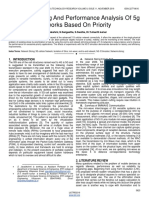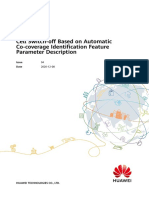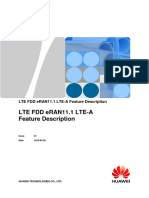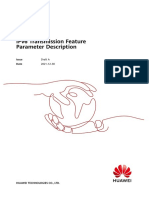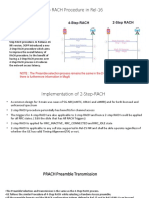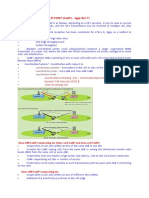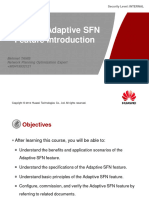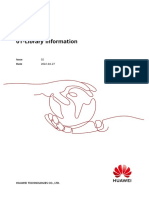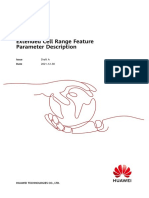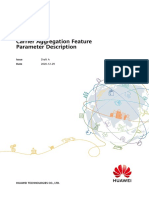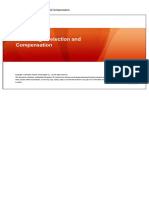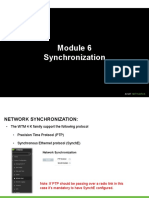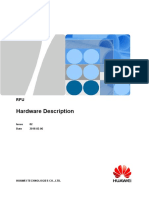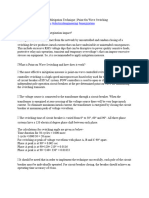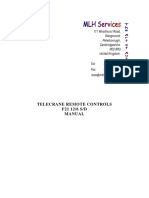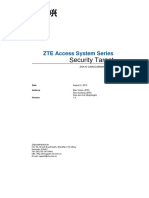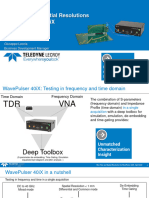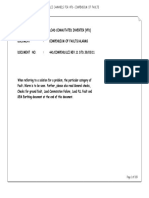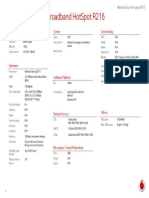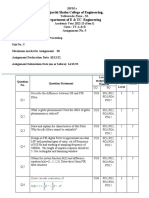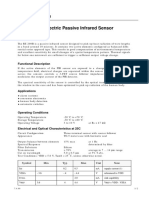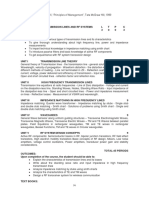Extended Cell Range
Uploaded by
Ahmed YunesExtended Cell Range
Uploaded by
Ahmed YuneseRAN
Extended Cell Range Feature
Parameter Description
Issue Draft A
Date 2020-12-29
HUAWEI TECHNOLOGIES CO., LTD.
Copyright © Huawei Technologies Co., Ltd. 2021. All rights reserved.
No part of this document may be reproduced or transmitted in any form or by any means without prior
written consent of Huawei Technologies Co., Ltd.
Trademarks and Permissions
and other Huawei trademarks are trademarks of Huawei Technologies Co., Ltd.
All other trademarks and trade names mentioned in this document are the property of their respective
holders.
Notice
The purchased products, services and features are stipulated by the contract made between Huawei and
the customer. All or part of the products, services and features described in this document may not be
within the purchase scope or the usage scope. Unless otherwise specified in the contract, all statements,
information, and recommendations in this document are provided "AS IS" without warranties, guarantees
or representations of any kind, either express or implied.
The information in this document is subject to change without notice. Every effort has been made in the
preparation of this document to ensure accuracy of the contents, but all statements, information, and
recommendations in this document do not constitute a warranty of any kind, express or implied.
Huawei Technologies Co., Ltd.
Address: Huawei Industrial Base
Bantian, Longgang
Shenzhen 518129
People's Republic of China
Website: https://www.huawei.com
Email: support@huawei.com
Issue Draft A Copyright © Huawei Technologies Co., Ltd. i
(2020-12-29)
eRAN
Extended Cell Range Feature Parameter Description Contents
Contents
1 Change History.........................................................................................................................1
1.1 eRAN17.1 Draft A (2020-12-29)........................................................................................................................................ 1
2 About This Document.............................................................................................................3
2.1 General Statements................................................................................................................................................................ 3
2.2 Applicable RAT......................................................................................................................................................................... 3
2.3 Features in This Document.................................................................................................................................................. 3
3 General Principles....................................................................................................................5
3.1 Introduction............................................................................................................................................................................... 5
3.2 Random Access Preamble Format..................................................................................................................................... 6
4 Cell Radius Less Than 15 km................................................................................................ 8
4.1 Principles.................................................................................................................................................................................... 8
4.2 Network Analysis..................................................................................................................................................................... 8
4.2.1 Benefits.................................................................................................................................................................................... 8
4.2.2 Impacts.................................................................................................................................................................................... 8
4.3 Requirements............................................................................................................................................................................ 9
4.3.1 Licenses................................................................................................................................................................................... 9
4.3.2 Software.................................................................................................................................................................................. 9
4.3.3 Hardware................................................................................................................................................................................ 9
4.3.4 Networking............................................................................................................................................................................ 9
4.4 Operation and Maintenance............................................................................................................................................. 15
4.4.1 Data Configuration........................................................................................................................................................... 15
4.4.1.1 Data Preparation............................................................................................................................................................ 15
4.4.1.2 Using MML Commands............................................................................................................................................... 16
4.4.1.3 Using the MAE-Deployment...................................................................................................................................... 17
4.4.2 Activation Verification..................................................................................................................................................... 17
4.4.3 Network Monitoring......................................................................................................................................................... 18
5 Cell Radius Greater Than 15 km........................................................................................19
5.1 Principles.................................................................................................................................................................................. 19
5.2 Network Analysis.................................................................................................................................................................. 19
5.2.1 Benefits................................................................................................................................................................................. 19
5.2.2 Impacts.................................................................................................................................................................................. 19
5.3 Requirements......................................................................................................................................................................... 21
Issue Draft A Copyright © Huawei Technologies Co., Ltd. ii
(2020-12-29)
eRAN
Extended Cell Range Feature Parameter Description Contents
5.3.1 Licenses................................................................................................................................................................................. 21
5.3.2 Software................................................................................................................................................................................21
5.3.3 Hardware.............................................................................................................................................................................. 23
5.3.4 Networking.......................................................................................................................................................................... 24
5.4 Operation and Maintenance............................................................................................................................................. 24
5.4.1 Data Configuration........................................................................................................................................................... 24
5.4.1.1 Data Preparation............................................................................................................................................................ 24
5.4.1.2 Using MML Commands............................................................................................................................................... 24
5.4.1.3 Using the MAE-Deployment...................................................................................................................................... 24
5.4.2 Activation Verification..................................................................................................................................................... 24
5.4.3 Network Monitoring......................................................................................................................................................... 25
6 Cell Radius Greater Than 100 km (FDD)......................................................................... 26
6.1 Principles.................................................................................................................................................................................. 26
6.2 Network Analysis.................................................................................................................................................................. 26
6.2.1 Benefits................................................................................................................................................................................. 26
6.2.2 Impacts.................................................................................................................................................................................. 26
6.3 Requirements......................................................................................................................................................................... 28
6.3.1 Licenses................................................................................................................................................................................. 28
6.3.2 Software................................................................................................................................................................................29
6.3.3 Hardware.............................................................................................................................................................................. 32
6.3.4 Networking.......................................................................................................................................................................... 33
6.4 Operation and Maintenance............................................................................................................................................. 33
6.4.1 Data Configuration........................................................................................................................................................... 33
6.4.1.1 Data Preparation............................................................................................................................................................ 33
6.4.1.2 Using MML Commands............................................................................................................................................... 33
6.4.1.3 Using the MAE-Deployment...................................................................................................................................... 33
6.4.2 Activation Verification..................................................................................................................................................... 34
6.4.3 Network Monitoring......................................................................................................................................................... 34
7 Parameters.............................................................................................................................. 35
8 Counters.................................................................................................................................. 36
9 Glossary................................................................................................................................... 37
10 Reference Documents........................................................................................................ 38
Issue Draft A Copyright © Huawei Technologies Co., Ltd. iii
(2020-12-29)
eRAN
Extended Cell Range Feature Parameter Description 1 Change History
1 Change History
This chapter describes changes not included in the "Parameters", "Counters",
"Glossary", and "Reference Documents" chapters. These changes include:
● Technical changes
Changes in functions and their corresponding parameters
● Editorial changes
Improvements or revisions to the documentation
1.1 eRAN17.1 Draft A (2020-12-29)
This issue introduces the following changes to eRAN16.1 02 (2020-07-03).
Technical Changes
Change Description Parameter Change RAT Base Station
Model
Added the mutually None FDD 3900 and 5900
exclusive relationship series base
between cell radius stations
greater than 100 km
and Dynamic
Dedicated Beam/
Static Shared Beam/
Hybrid DSS Based on
Asymmetric
Bandwidth. For
details, see 6.3.2
Software.
Issue Draft A Copyright © Huawei Technologies Co., Ltd. 1
(2020-12-29)
eRAN
Extended Cell Range Feature Parameter Description 1 Change History
Change Description Parameter Change RAT Base Station
Model
Added the mutually None FDD 3900 and 5900
exclusive relationship series base
between cell radius stations
greater than 15 km
and Static Shared
Beam/Dynamic
Dedicated Beam. For
details, see 5.3.2
Software.
Editorial Changes
Revised descriptions in this document.
Issue Draft A Copyright © Huawei Technologies Co., Ltd. 2
(2020-12-29)
eRAN
Extended Cell Range Feature Parameter Description 2 About This Document
2 About This Document
2.1 General Statements
Purpose
This document is intended to acquaint readers with:
● The technical principles of features and their related parameters
● The scenarios where these features are used, the benefits they provide, and
the impact they have on networks and functions
● Requirements of the operating environment that must be met before feature
activation
● Parameter configuration required for feature activation, verification of feature
activation, and monitoring of feature performance
NOTE
This document only provides guidance for feature activation. Feature deployment and
feature gains depend on the specifics of the network scenario where the feature is
deployed. To achieve the desired gains, contact Huawei professional service engineers.
Software Interfaces
Any parameters, alarms, counters, or managed objects (MOs) described in this
document apply only to the corresponding software release. For future software
releases, refer to the corresponding updated product documentation.
2.2 Applicable RAT
This document applies to FDD.
2.3 Features in This Document
This document describes the following FDD features.
Issue Draft A Copyright © Huawei Technologies Co., Ltd. 3
(2020-12-29)
eRAN
Extended Cell Range Feature Parameter Description 2 About This Document
Feature ID Feature Name Chapter/Section
LBFD-002012 Cell Access Radius up 4 Cell Radius Less Than 15 km
to 15km
LOFD-001009 Extended Cell Access 5 Cell Radius Greater Than 15 km
Radius
LOFD-081223 Extended Cell Access 6 Cell Radius Greater Than 100 km (FDD)
Radius Beyond 100km
Issue Draft A Copyright © Huawei Technologies Co., Ltd. 4
(2020-12-29)
eRAN
Extended Cell Range Feature Parameter Description 3 General Principles
3 General Principles
Nowadays, mobile communications networks cover most of the inland areas, but
rural areas, remote areas such as at sea, or in the desert, or grasslands, have poor
coverage due to site acquisition problems. It is difficult to find suitable site
locations at sea. Site deployment as usual in the desert or in grasslands (where
traffic is light) requires excessively huge investment.
In addition to this, extended coverage in these areas increases access delay and
requires enhanced coverage. In this situation, Huawei eNodeBs use the extended
cell range feature.
3.1 Introduction
Extended cell range helps operators increase the cell radius up to 200 km
theoretically, to expand cell coverage.
NOTE
In this document, the cell radius is the theoretical cell radius with the corresponding
extended cell range feature enabled. The actual cell radius is the farthest location that the
radio signal covers away from the site center. The actual cell radius is typically less than the
theoretical one.
Table 3-1 lists the functions included in extended cell range and their application
scenarios.
Table 3-1 Functions included in extended cell range and their application scenarios
Function Application Scenario
Cell radius less than 15 km The cell radius is less than or equal to 15 km.
Cell radius greater than 15 km The cell radius is in the range of (15 km, 100 km].
Cell radius greater than 100 The cell radius is in the range of (100 km, 200 km].
km
As shown in Figure 3-1, with the cell radius greater than 100 km function
enabled, the theoretical coverage area is the ring area B. N (0 km < N ≤ 100 km)
Issue Draft A Copyright © Huawei Technologies Co., Ltd. 5
(2020-12-29)
eRAN
Extended Cell Range Feature Parameter Description 3 General Principles
and N + 100 km denote the nearest and farthest locations of the cell coverage
away from the site center. In this scenario, UEs that are located in area A cannot
access this cell. To provide services in area A, operators need to deploy other
common cells to provide the coverage.
Figure 3-1 Example of the coverage area of a cell with the cell radius greater than
100 km
3.2 Random Access Preamble Format
In accordance with section 5.7 in 3GPP TS 36.211 of Release 8 (2009 Q1), FDD
supports random access preamble formats 0 to 3 and TDD supports random
access preamble formats 0 to 4. A preamble format determines the cell coverage
and the time domain resources that can be used by a physical random access
channel (PRACH).
In a random access procedure, the eNodeB detects the preamble sequences
transmitted from a UE, estimates the round-trip delay (RTD), and completes the
synchronization for the UE.
RTD between the eNodeB and the UE increases with the cell radius, denoted by R.
It is calculated using the following formula:
Extended cell range uses different random access preamble formats to adapt to
different RTDs. The random access preamble format and cell radius are specified
by the Cell.PreambleFmt and Cell.CellRadius parameters, respectively.
In FDD, different preamble formats correspond to different cell radii and RTDs, as
listed in Table 3-2.
Table 3-2 Mapping between FDD random access preamble formats and cell radii
Preamble Format Cyclic Prefix (CP) Cell Radius (R) (km) Maximum RTD (µs)
Length TCP (µs)
0 103.1 R ≤ 14.5 96.7
1 684.4 R ≤ 77.3 515.6
Issue Draft A Copyright © Huawei Technologies Co., Ltd. 6
(2020-12-29)
eRAN
Extended Cell Range Feature Parameter Description 3 General Principles
Preamble Format Cyclic Prefix (CP) Cell Radius (R) (km) Maximum RTD (µs)
Length TCP (µs)
2 203.1 R ≤ 29.5 196.8
3 684.4 R ≤ 100 666.7
NOTE
Set the random access preamble format in FDD based on the cell radius as follows:
● If the cell radius is less than or equal to 15 km, the recommended preamble format is
0.
● If the cell radius is greater than 15 km, the recommended preamble format is 1, 2, or
3.
● If the cell radius is greater than 100 km, the recommended preamble format is 3.
Issue Draft A Copyright © Huawei Technologies Co., Ltd. 7
(2020-12-29)
eRAN
Extended Cell Range Feature Parameter Description 4 Cell Radius Less Than 15 km
4 Cell Radius Less Than 15 km
4.1 Principles
For details, see 3 General Principles.
4.2 Network Analysis
4.2.1 Benefits
Extended cell range increases cell coverage to meet communication requirements
in rural and remote areas such as at sea, in the desert, and in grasslands,
significantly decreasing the cost to deploy sites in such areas.
Extended cell range addresses the delay and fading caused by remote coverage. To
use extended cell range, operators need to obtain the actual coverage radius of a
cell. It is recommended that this function be enabled when the maximum
coverage distance of a cell is less than or equal to 15 km. This function is a basic
function. It is enabled by default and does not need to be activated or deactivated.
In high-speed or ultra-high-speed scenarios: In addition to the parameters
described in this document, other parameters may affect the access. For details
about the definition of high and low speeds and related parameter settings and
selection, see High Speed Mobility.
4.2.2 Impacts
Network Impacts
None
Function Impacts
None
Issue Draft A Copyright © Huawei Technologies Co., Ltd. 8
(2020-12-29)
eRAN
Extended Cell Range Feature Parameter Description 4 Cell Radius Less Than 15 km
4.3 Requirements
4.3.1 Licenses
This function is a basic function and is not under license control.
4.3.2 Software
Prerequisite Functions
None
Mutually Exclusive Functions
None
4.3.3 Hardware
Base Station Models
The following base stations are compatible with this function:
3900 and 5900 series base stations
Boards
No requirements
RF Modules
No requirements
4.3.4 Networking
It is recommended that the following networking planning policies be used to
ensure better service rates at the cell edge with extended cell range:
● Deploying distributed eNodeBs
A distributed eNodeB has two types of basic modules: the baseband unit
(BBU) and remote radio unit (RRU), which are deployed in a distributed
architecture. The BBU is installed in a cabinet, while RRUs are installed close
to the antenna system. The BBU and RRUs are connected using optical fibers.
Compared with macro eNodeBs under the same site conditions, distributed
eNodeBs can reduce feeder costs and loss for the antenna system and obtain
a gain in the range of 2.5 dB to 3 dB, increasing cell coverage. Figure 4-1
shows the installation scenarios of a macro eNodeB and distributed eNodeB.
Issue Draft A Copyright © Huawei Technologies Co., Ltd. 9
(2020-12-29)
eRAN
Extended Cell Range Feature Parameter Description 4 Cell Radius Less Than 15 km
Figure 4-1 Installation scenario comparison between a macro eNodeB and a
distributed eNodeB
● Power amplifier
A Huawei eNodeB enhances downlink coverage by supporting up to 80 W TX
power.
● Using tower-mounted amplifiers (TMAs)
A TMA is a low noise amplifier, which reduces the RX noise factor and
increases RX sensitivity of the eNodeB. On a live network, TMAs are installed
near RX antennas to improve RX performance.
If the equipment room is far from the antenna tower, resulting in a feeder
loss greater than 2.2 dB, TMAs can be installed to eliminate the impact of
feeder loss on RX sensitivity. TMAs improve RX performance. However, TMAs
also bring an insertion loss of about 0.5 dB to the downlink.
● Antenna altitude
A valid antenna altitude consists of two parts: mountain altitude and altitude
from the antennas to the ground, as shown in Figure 4-2. Due to limitations
on the altitude of a tower or pole where the antennas are mounted, the
maximum altitude from the antennas to the ground is 70 m.
Figure 4-2 Example of a valid antenna altitude
On a live network, the antenna's effective altitude determines the cell
coverage. Therefore, when planning the antenna altitude, ensure that the
Issue Draft A Copyright © Huawei Technologies Co., Ltd. 10
(2020-12-29)
eRAN
Extended Cell Range Feature Parameter Description 4 Cell Radius Less Than 15 km
target cell coverage is within a line of sight (LOS). Non line of sight (NLOS)
areas may experience signal attenuation and poor cell coverage due to the
Earth's curvature.
For antenna altitude planned above the sea level, Huawei provides a
segmentation model to describe radio propagation on the sea, shown in
Figure 4-3.
Figure 4-3 Segmentation model for radio propagation on the sea
As shown in the preceding figure:
– Ht denotes the site altitude above sea level.
– Hr denotes the UE altitude above sea level.
– d1 denotes the LOS path A on the sea.
– d2 denotes the LOS path B on the sea.
– Re denotes the Earth radius.
– d denotes path C on the sea, which is a shadow area with poor signal
quality due to the Earth's curvature, and therefore this path can be
ignored during network planning.
According to the Huawei segmentation model for radio propagation on the
sea, the following tables list the path losses calculated based on the site
altitudes, UE altitudes, and LOS distances above sea level at a site with center
frequencies of 800 MHz and 450 MHz.
– 800 MHz: Table 4-1 and Table 4-2
– 450 MHz: Table 4-3 and Table 4-4
Issue Draft A Copyright © Huawei Technologies Co., Ltd. 11
(2020-12-29)
eRAN
Extended Cell Range Feature Parameter Description 4 Cell Radius Less Than 15 km
NOTE
The path losses with other center frequencies can be calculated based on that of 800
MHz or 450 MHz. Take the path loss calculation of a center frequency of 1800 MHz
based on the path loss with a center frequency of 800 MHz as an example. Delta
denotes the pass loss difference against 800 MHz. Delta = 20 x [log(1800) – log(800)].
The pass loss of a center frequency of 1800 MHz is equal to the sum of delta and the
pass loss of the center frequency of 800 MHz. The path loss of a center frequency of
1800 MHz can be calculated using the same method based on that of 450 MHz. The
path losses are for reference only.
Table 4-1 Path losses calculated based on site altitudes, UE altitudes (Hr = 2 m), and LOS distances
above sea level at a site with a center frequency of 800 MHz
Ht (m) d1 (km) Path Loss d2 (km) d1+d2 (km) Path Loss
(dB) (dB)
50 29.2 128.7 5.8 35.0 136.8
60 31.9 129.6 5.8 37.8 137.7
70 34.5 130.5 5.8 40.3 138.3
80 36.9 131.3 5.8 42.7 139.0
90 39.1 131.9 5.8 44.9 139.5
100 41.2 132.5 5.8 47.1 140.3
200 58.3 136.4 5.8 64.1 143.6
300 71.4 138.7 5.8 77.2 145.8
400 82.5 140.4 5.8 88.3 147.6
500 92.2 141.7 5.8 98.0 148.7
Table 4-2 Path losses calculated based on site altitudes, UE altitudes (Hr = 10 m), and LOS
distances above sea level at a site with a center frequency of 800 MHz
Ht (m) d1 (km) Path Loss d2 (km) d1+d2 (km) Path Loss
(dB) (dB)
50 29.2 128.6 13.0 42.2 138.9
60 31.9 129.6 13.0 45.0 139.7
70 34.5 130.5 13.0 47.5 140.1
80 36.9 131.3 13.0 49.9 140.8
90 39.1 131.9 13.0 52.2 141.5
100 41.2 132.5 13.0 54.3 141.9
200 58.3 136.4 13.0 71.3 144.8
Issue Draft A Copyright © Huawei Technologies Co., Ltd. 12
(2020-12-29)
eRAN
Extended Cell Range Feature Parameter Description 4 Cell Radius Less Than 15 km
Ht (m) d1 (km) Path Loss d2 (km) d1+d2 (km) Path Loss
(dB) (dB)
300 71.4 138.7 13.0 84.5 147.2
400 82.5 140.4 13.0 95.5 148.5
500 92.2 141.6 13.0 105.2 149.5
Table 4-3 Path losses calculated based on site altitudes, UE altitudes (Hr = 2 m), and LOS distances
above sea level at a site with a center frequency of 450 MHz
Ht (m) d1 (km) Path Loss d2 (km) d1+d2 (km) Path Loss
(dB) (dB)
50 29.2 123.7 5.8 35.0 131.8
60 31.9 124.6 5.8 37.8 132.7
70 34.5 125.5 5.8 40.3 133.3
80 36.9 126.3 5.8 42.7 134.0
90 39.1 126.9 5.8 44.9 134.4
100 41.2 127.5 5.8 47.1 135.2
200 58.3 131.5 5.8 64.1 138.6
300 71.4 133.7 5.8 77.2 140.7
400 82.5 135.4 5.8 88.3 142.5
500 92.2 136.7 5.8 98.0 143.6
600 101 137.7 5.8 106.8 144.6
700 109.1 138.6 5.8 114.9 145.5
800 116.7 139.4 5.8 122.5 146.5
900 123.7 140.0 5.8 129.5 147.0
1100 136.8 141.2 5.8 142.6 148.3
1300 148.7 142.1 5.8 154.5 149.3
Table 4-4 Path losses calculated based on site altitudes, UE altitudes (Hr = 10 m), and LOS
distances above sea level at a site with a center frequency of 450 MHz
Ht (m) d1 (km) Path Loss d2 (km) d1+d2 (km) Path Loss
(dB) (dB)
50 29.2 123.6 13.0 42.2 133.9
Issue Draft A Copyright © Huawei Technologies Co., Ltd. 13
(2020-12-29)
eRAN
Extended Cell Range Feature Parameter Description 4 Cell Radius Less Than 15 km
Ht (m) d1 (km) Path Loss d2 (km) d1+d2 (km) Path Loss
(dB) (dB)
60 31.9 124.6 13.0 45.0 134.7
70 34.5 125.5 13.0 47.5 135.1
80 36.9 126.3 13.0 49.9 135.8
90 39.1 126.9 13.0 52.2 136.4
100 41.2 127.5 13.0 54.3 136.8
200 58.3 131.4 13.0 71.3 139.8
300 71.4 133.7 13.0 84.5 142.0
400 82.5 135.4 13.0 95.5 143.4
500 92.2 136.6 13.0 105.2 144.4
600 101 137.7 13.0 114.0 145.4
700 109.1 138.5 13.0 122.1 146.2
800 116.7 139.3 13.0 129.7 147.2
900 123.7 140.0 13.0 136.7 147.6
1100 136.8 141.1 13.0 149.8 148.9
1300 148.7 142.1 13.0 161.7 149.8
When deploying extended cell range at sea, calculate the antenna altitude
based on the LOS distances (d1 + d2) listed in the preceding tables. When
deploying extended cell range in deserts or on grasslands, calculate the
antenna altitude based on the LOS distance d1 as listed in the preceding
tables.
If the antenna altitude of a site is too high, the antennas may receive radio
signals from too large an area, resulting in interference at the site. Calculate
the antenna altitude at an allowable height based on the distance between
the site and the target cell coverage to meet requirements for deploying
extended cell range on seas.
● Site acquisition
The deployment of extended cell range requires good radio environment.
Therefore, the following requirements must be met for site acquisition:
– There are no obvious obstacles in the target area to be covered by the
eNodeB. LOS areas are preferred.
– The site altitude is as high as possible based on coverage requirements.
– Extended cell coverage provided by the GERAN or UTRAN is preferentially
selected as the target cell coverage for the E-UTRAN.
– Other requirements are the same as those for macro networks.
Issue Draft A Copyright © Huawei Technologies Co., Ltd. 14
(2020-12-29)
eRAN
Extended Cell Range Feature Parameter Description 4 Cell Radius Less Than 15 km
● Channel power allocation
Channel power is allocated according to the configuration baseline of channel
power for macro networks.
● Antenna selection
– In most cases, it is recommended that 18 dBi antennas with a half-power
beamwidth of 65° be used.
– When deployed at sea, the antennas are mounted as high as possible, in
order to resist the effect of the Earth's curvature. However, this may also
create coverage holes for areas near the antennas. In this scenario,
suitable antennas must be selected to avoid coverage holes. In addition,
antennas with smaller surface areas are recommended, to resist the
ocean wind, which also reduces the wind resistance on the tower or pole
where the antennas are mounted.
– In open areas, vertically polarized antennas have better performance than
other types of polarized antennas. If wide cell coverage is required,
vertically polarized antennas are recommended.
– Non-RET antennas can be used for scenarios that do not require tilt
adjustment. At a site with an extremely high altitude, antenna tilts can be
adjusted electronically or mechanically to ensure cell coverage for both
remote and local areas. RET is short for remote electrical tilt.
4.4 Operation and Maintenance
4.4.1 Data Configuration
4.4.1.1 Data Preparation
Low-Speed Cell with Extended Cell Range
Table 4-5 describes the parameters used for function activation.
Table 4-5 Parameters used for activation
Parameter Parameter ID Setting Notes
Name
Preamble format Cell.PreambleFmt Set this parameter to its recommended value.
Cell radius Cell.CellRadius Set the parameter to a value greater than or
equal to the actual cell radius.
If the cell radius is greater than 100 km, take
the Cell.CellRadiusStartLocation parameter
setting into consideration when setting this
parameter. It is recommended that the value of
this parameter be equal to the sum of 100 km
and the value of the Cell.CellRadiusStartLoca-
tion parameter.
Issue Draft A Copyright © Huawei Technologies Co., Ltd. 15
(2020-12-29)
eRAN
Extended Cell Range Feature Parameter Description 4 Cell Radius Less Than 15 km
Parameter Parameter ID Setting Notes
Name
Cell Radius Start Cell.CellRadiusStartLoca- This parameter value must be less than the
Location tion Cell.CellRadius parameter value. The value
difference between the Cell.CellRadius
parameter and this parameter must be less
than or equal to 100000. Set this parameter to
a value greater than 0 only when the cell radius
is greater than 100 km.
Standard Ratio BBP.SRT This parameter specifies the resource ratio for
LTE. Currently, only UBBP boards support this
parameter. If other baseband processing boards
are used, this parameter is invalid. If the cell
radius is in the range of 160 km to 200 km, set
this parameter based on the RAT planning
when adding a BBP.
High-Speed or Ultra-High-Speed Cell with Extended Cell Range
Table 4-6 describes the parameters used for function activation.
Table 4-6 Parameters used for activation
Parameter Parameter ID Setting Notes
Name
Preamble format Cell.PreambleFmt Set this parameter to its recommended value.
Cell radius Cell.CellRadius Set the parameter to a value greater than or
equal to the actual cell radius. The maximum
values for cells supporting high speed mobility
and ultra high speed mobility are 32800 and
17200, respectively.
For details about definitions of and parameters related to high-speed and ultra-
high-speed cells, see High Speed Mobility.
4.4.1.2 Using MML Commands
Activation Command Examples
//Setting the cell radius and preamble format according to the network plan
MOD CELL: LocalCellId=0, PreambleFmt=0, CellRadius=10000;
Optimization Command Examples
N/A
Issue Draft A Copyright © Huawei Technologies Co., Ltd. 16
(2020-12-29)
eRAN
Extended Cell Range Feature Parameter Description 4 Cell Radius Less Than 15 km
4.4.1.3 Using the MAE-Deployment
For detailed operations, see Feature Configuration Using the MAE-Deployment.
4.4.2 Activation Verification
Step 1 Check that the cell has been successfully activated, and then start tracing over the
Uu interface on the MAE-Access.
Step 2 Run the MOD CELL command to configure a preamble format for the cell. The
cell will be automatically deactivated and then reactivated. Wait until the cell is
set up, and then check the decimal value of the IE prach-ConfigIndex in the first
RRC_SYS_INFO (SIB2) message over the Uu interface. For example, in the
following figure, the value of this IE is 3.
● If the value of this IE is from 0 to 15, the Preamble format parameter has
been set to 0.
● If the value of this IE is from 16 to 31, the Preamble format parameter has
been set to 1.
● If the value of this IE is from 32 to 47, the Preamble format parameter has
been set to 2.
● If the value of this IE is from 48 to 63, the Preamble format parameter has
been set to 3.
Figure 4-4 Example of querying the value of the IE prach-ConfigIndex
----End
Issue Draft A Copyright © Huawei Technologies Co., Ltd. 17
(2020-12-29)
eRAN
Extended Cell Range Feature Parameter Description 4 Cell Radius Less Than 15 km
4.4.3 Network Monitoring
Create signaling tracing tasks to monitor the performance. For details, see 4.4.2
Activation Verification.
Issue Draft A Copyright © Huawei Technologies Co., Ltd. 18
(2020-12-29)
eRAN
Extended Cell Range Feature Parameter Description 5 Cell Radius Greater Than 15 km
5 Cell Radius Greater Than 15 km
5.1 Principles
For details, see 3 General Principles.
5.2 Network Analysis
5.2.1 Benefits
Extended cell range increases cell coverage to meet communication requirements
in rural and remote areas such as at sea, in the desert, and in grasslands,
significantly decreasing the cost to deploy sites in such areas.
Extended cell range addresses the delay and fading caused by remote coverage. To
use extended cell range, operators need to obtain the actual coverage radius of a
cell. It is recommended that this function be enabled when the maximum
coverage distance of a cell is in the interval of (15 km, 100 km]. Set the cell radius
based on the actual coverage radius (the cell radius can be greater than the actual
coverage radius) and configure the preamble format based on the cell radius.
In high-speed or ultra-high-speed scenarios: In addition to the parameters
described in this document, other parameters may affect the access. For details
about the definition of high and low speeds and related parameter settings and
selection, see High Speed Mobility.
5.2.2 Impacts
Network Impacts
● Coverage
The cell radius can be extended to up to 100 km.
● Impact on network KPIs
The random access success rate increases in the coverage area.
Issue Draft A Copyright © Huawei Technologies Co., Ltd. 19
(2020-12-29)
eRAN
Extended Cell Range Feature Parameter Description 5 Cell Radius Greater Than 15 km
Function Impacts
RAT Function Function Switch Reference Description
Name
FDD TTI bundling TtiBundlingSwitch option VoLTE Extended cell range leads
of the to the coverage limitation
CellAlgoSwitch.UlSchSwit in the uplink. TTI bundling
ch parameter enhances PUSCH coverage
and increases the MCS
indexes in uplink weak
coverage areas, enhancing
uplink coverage and
improving coverage quality.
FDD Uplink 2- None MIMO Extended cell range leads
antenna to the coverage limitation
receive in the uplink. Uplink multi-
diversity antenna technologies
enhance uplink coverage
and improve coverage
quality.
FDD Uplink 4- None MIMO Extended cell range leads
antenna to the coverage limitation
receive in the uplink. Uplink multi-
diversity antenna technologies
enhance uplink coverage
and improve coverage
quality.
FDD PUSCH IRC CellAlgoSwitch.PuschIrcAl MRC and Extended cell range leads
goSwitch IRC to the coverage limitation
Receivers in the uplink. Receiver
technologies are usually
used with uplink multi-
antenna technologies to
achieve a higher signal to
interference plus noise ratio
(SINR), enhancing uplink
coverage and improving
coverage quality.
FDD Smart SMART_CARRIER_SELECTI Multi-carrier Virtual grid models cannot
carrier ON_SW option of the Unified be built for cells whose
selection MultiCarrUnifiedSch.Multi Scheduling radius is greater than 15
based on CarrierUnifiedSchSw km.
virtual grids parameter
Issue Draft A Copyright © Huawei Technologies Co., Ltd. 20
(2020-12-29)
eRAN
Extended Cell Range Feature Parameter Description 5 Cell Radius Greater Than 15 km
RAT Function Function Switch Reference Description
Name
FDD Downlink 4TxTM9MuMimoSwitch eMIMO In extended cell range
MU-MIMO option of the (FDD) scenarios, TM9 is generally
in TM9 CellAlgoSwitch.EmimoSwi not used.
tch parameter In such scenarios, the
capacity is not high, the
user number is small, and
the traffic volume is low.
Therefore, the pairing rate
is low and the MU-MIMO
benefits are not apparent.
FDD WTTx MU- Tm9FourLayerPairSwitch WTTx MU- In extended cell range
MIMO option of the MIMO scenarios, TM9 is generally
CellAlgoExtSwitch.WttxM (FDD) not used.
uMimoSwitch parameter In such scenarios, the
capacity is not high, the
user number is small, and
the traffic volume is low.
Therefore, the pairing rate
is low and the MU-MIMO
benefits are not apparent.
FDD Intra- CellCspcPara.IntraEnbCspc CSPC Intra-eNodeB CSPC is
eNodeB Sw suitable for densely
CSPC populated urban areas. It is
not recommended for cells
with radius greater than 15
km.
5.3 Requirements
5.3.1 Licenses
RAT Feature ID Feature Name Model Sales Unit
FDD LOFD-001009 Extended Cell LT1S00ECAR00 per Cell
Access Radius
5.3.2 Software
Before activating this function, ensure that its prerequisite functions have been
activated and mutually exclusive functions have been deactivated. For detailed
operations, see the relevant feature documents.
Issue Draft A Copyright © Huawei Technologies Co., Ltd. 21
(2020-12-29)
eRAN
Extended Cell Range Feature Parameter Description 5 Cell Radius Greater Than 15 km
Prerequisite Functions
None
Mutually Exclusive Functions
RAT Function Function Switch Reference Description
Name
FDD CSPC CellCspcPara.CellCspcSwit CSPC The larger the cell radius,
ch the lower the inter-cell
interference. Coordinated
scheduling-based power
control (CSPC) does not
apply to low-interference
scenarios.
FDD eCSPC CellCspcPara.CelleCspcSwi CSPC eCSPC requires that the
tch radius of each cell involved
should not exceed 15 km. If
the radius exceeds 15 km,
eCSPC does not take effect.
FDD UL CRA UL_COORD_RES_ALLOC_S Uplink When the cell radius is in
WITCH option of the Coordinated the interval of (15 km, 100
UlCsAlgoPara.UlCsSw Scheduling km], the traffic volume and
parameter the interference are weak,
which is not a gain-yielding
scenario of uplink
coordinated scheduling.
FDD UL CPC UL_COORD_PC_SWITCH Uplink When the cell radius is in
option of the Coordinated the interval of (15 km, 100
UlCsAlgoPara.UlCsSw Scheduling km], the traffic volume and
parameter the interference are weak,
which is not a gain-yielding
scenario of uplink
coordinated scheduling.
FDD Static None Massive Massive MIMO does not
Shared MIMO support a cell radius
Beam (FDD) greater than 15 km.
FDD Dynamic None Massive Massive MIMO does not
Dedicated MIMO support a cell radius
Beam (FDD) greater than 15 km.
FDD Intelligent MM_INTELLIGENT_BEAM_ Massive Massive MIMO does not
beam SHAPING_SW option of MIMO support a cell radius
shaping the (FDD) greater than 15 km.
SectorSplitGroup.SectorSp
litSwitch parameter
Issue Draft A Copyright © Huawei Technologies Co., Ltd. 22
(2020-12-29)
eRAN
Extended Cell Range Feature Parameter Description 5 Cell Radius Greater Than 15 km
RAT Function Function Switch Reference Description
Name
FDD DL CoMP HomNet: DL CoMP In DL CoMP, UEs need to
with TM10 FDDHomNetDlCompS- (FDD) receive data from different
witch option of the cells simultaneously.
CellAlgoSwitch.DlCompSw Therefore, DL CoMP does
itch parameter not apply to extended
HetNet: coverage scenarios.
FDDHetNetDlCompSwitch
option of the
CellAlgoSwitch.DlCompSw
itch parameter
FDD Uplink joint UL_JOINT_INTRF_SUPPRES Interference Uplink joint interference
interference S_SW option of the Detection management requires that
managemen UlInterfSuppressCfg.UlJoi and the radius of each cell
t ntIntrfManagementSw Suppression involved should not exceed
parameter 15 km. If the radius exceeds
15 km, uplink joint
interference management
does not take effect.
FDD Static None 3D The cell radius greater than
Shared Beamformin 15 km function does not
Beam g (FDD) work at passive ports on
AAUs.
FDD Dynamic None 3D None
Dedicated Beamformin
Beam g (FDD)
FDD Static None Smart 8T8R None
Shared (FDD)
Beam
FDD Dynamic None Smart 8T8R None
Dedicated (FDD)
Beam
5.3.3 Hardware
Base Station Models
The following base stations are compatible with this function:
3900 and 5900 series base stations
Boards
No requirements
Issue Draft A Copyright © Huawei Technologies Co., Ltd. 23
(2020-12-29)
eRAN
Extended Cell Range Feature Parameter Description 5 Cell Radius Greater Than 15 km
RF Modules
No requirements
5.3.4 Networking
For details, see 4.3.4 Networking.
5.4 Operation and Maintenance
5.4.1 Data Configuration
5.4.1.1 Data Preparation
For details, see 4.4.1.1 Data Preparation.
5.4.1.2 Using MML Commands
Activation Command Examples
//Setting the cell radius and preamble format according to the network plan
MOD CELL: LocalCellId=0, PreambleFmt=2, CellRadius=17000;
Optimization Command Examples
N/A
5.4.1.3 Using the MAE-Deployment
For detailed operations, see Feature Configuration Using the MAE-Deployment.
5.4.2 Activation Verification
Verifying Preamble Format Configuration
For details, see 4.4.2 Activation Verification.
Observing the Extended Cell Access Radius Feature
Step 1 On the MAE-Access, run the LST CELL command and check the value of Cell
radius. If it is not greater than 15000, the Extended Cell Access Radius feature has
not taken effect. If it is greater than 15000, write it down and proceed to the next
step.
Step 2 On the MAE-Access, run the DSP LICINFO command and check the Actual Used
value corresponding to Extended Cell Access Radius(per Cell)(FDD). If the value is
0, the feature has not taken effect. If the value is greater than 0, write it down
and proceed to the next step.
Step 3 On the MAE-Access, run the MOD CELL command with the Cell radius parameter
set to 10000. If necessary, change the value of the Preamble format parameter.
Issue Draft A Copyright © Huawei Technologies Co., Ltd. 24
(2020-12-29)
eRAN
Extended Cell Range Feature Parameter Description 5 Cell Radius Greater Than 15 km
Step 4 Run the DSP CELL command and verify that the cell has been successfully
activated. Run the DSP LICINFO command and check the value of Actual Used
corresponding to Extended Cell Access Radius(per Cell)(FDD).
● If this value equals that obtained in Step 2, the feature had not been
activated before you modified Cell radius.
● If this value equals that obtained in Step 2 minus 1, the feature had been
activated before you modified Cell radius. Write down this value and proceed
to the next step.
Step 5 On the MAE-Access, run the MOD CELL command with Cell radius set to the
value obtained in Step 1.
Step 6 Run the DSP CELL command and verify that the cell has been successfully
activated. Run the DSP LICINFO command and check the value of Actual Used
corresponding to Extended Cell Access Radius(per Cell)(FDD). If this value equals
that obtained in Step 4 plus 1, the feature has already been activated.
----End
5.4.3 Network Monitoring
Create signaling tracing tasks to monitor the performance. For details, see 5.4.2
Activation Verification.
Issue Draft A Copyright © Huawei Technologies Co., Ltd. 25
(2020-12-29)
eRAN
Extended Cell Range Feature Parameter Description 6 Cell Radius Greater Than 100 km (FDD)
6 Cell Radius Greater Than 100 km (FDD)
6.1 Principles
For details, see 3 General Principles.
6.2 Network Analysis
6.2.1 Benefits
Extended cell range increases cell coverage to meet communication requirements
in rural and remote areas such as at sea, in the desert, and in grasslands,
significantly decreasing the cost to deploy sites in such areas.
Extended cell range addresses the delay and fading caused by remote coverage. To
use extended cell range, operators need to obtain the actual coverage radius of a
cell. It is recommended that this function be enabled when the maximum
coverage distance of a cell is greater than 100 km.
In high-speed or ultra-high-speed scenarios: In addition to the parameters
described in this document, other parameters may affect the access. For details
about the definition of high and low speeds and related parameter settings and
selection, see High Speed Mobility.
6.2.2 Impacts
Network Impacts
The cell radius can be extended to up to 200 km.
Issue Draft A Copyright © Huawei Technologies Co., Ltd. 26
(2020-12-29)
eRAN
Extended Cell Range Feature Parameter Description 6 Cell Radius Greater Than 100 km (FDD)
Function Impacts
Function Function Switch Reference Description
Name
TTI bundling TtiBundlingSwitch option of VoLTE Extended cell range leads to
the the coverage limitation in the
CellAlgoSwitch.UlSchSwitch uplink. TTI bundling enhances
parameter PUSCH coverage and increases
the MCS indexes in uplink
weak coverage areas,
enhancing uplink coverage and
improving coverage quality.
Uplink 2- None MIMO Extended cell range leads to
antenna the coverage limitation in the
receive uplink. Uplink multi-antenna
diversity technologies enhance uplink
coverage and improve
coverage quality.
Uplink 4- None MIMO Extended cell range leads to
antenna the coverage limitation in the
receive uplink. Uplink multi-antenna
diversity technologies enhance uplink
coverage and improve
coverage quality.
PUSCH IRC CellAlgoSwitch.PuschIrcAlgoS MRC and IRC Extended cell range leads to
witch Receivers the coverage limitation in the
uplink. Receiver technologies
are usually used with uplink
multi-antenna technologies to
achieve a higher signal to
interference plus noise ratio
(SINR), enhancing uplink
coverage and improving
coverage quality.
Downlink 4x2 None MIMO Cell radius greater than 100
MIMO km does not support channel
calibration. Therefore, cell
radius greater than 100 km
and closed-loop 4x2 MIMO
cannot be activated at the
same time. Otherwise, the
downlink performance
deteriorates. However, the cell
radius greater than 100 km
and open-loop 4x2 MIMO can
be activated at the same time.
Issue Draft A Copyright © Huawei Technologies Co., Ltd. 27
(2020-12-29)
eRAN
Extended Cell Range Feature Parameter Description 6 Cell Radius Greater Than 100 km (FDD)
Function Function Switch Reference Description
Name
Downlink 4x4 None MIMO Cell radius greater than 100
MIMO km does not support channel
calibration. Therefore, cell
radius greater than 100 km
and closed-loop 4x4 MIMO
cannot be activated at the
same time. Otherwise, the
downlink performance
deteriorates. However, the cell
radius greater than 100 km
and open-loop 4x4 MIMO can
be activated at the same time.
WTTx MU- Tm9FourLayerPairSwitch WTTx MU- In extended cell range
MIMO option of the MIMO (FDD) scenarios, TM9 is generally not
CellAlgoExtSwitch.WttxMuMi used.
moSwitch parameter In such scenarios, the capacity
is not high, the user number is
small, and the traffic volume is
low. Therefore, the pairing rate
is low and the MU-MIMO
benefits are not apparent.
Smart carrier SMART_CARRIER_SELECTION Multi-carrier Virtual grid models cannot be
selection _SW option of the Unified built for cells whose radius is
based on MultiCarrUnifiedSch.MultiCar Scheduling greater than 100 km.
virtual grids rierUnifiedSchSw parameter
Intra-eNodeB CellCspcPara.IntraEnbCspcSw CSPC Intra-eNodeB CSPC is suitable
CSPC for densely populated urban
areas. It is not recommended
for cells with radius greater
than 100 km.
6.3 Requirements
6.3.1 Licenses
Feature ID Feature Name Model Sales Unit
LOFD-081223 Extended Cell Access LT1S0ECARB00 Per Cell
Radius Beyond 100km
Issue Draft A Copyright © Huawei Technologies Co., Ltd. 28
(2020-12-29)
eRAN
Extended Cell Range Feature Parameter Description 6 Cell Radius Greater Than 100 km (FDD)
6.3.2 Software
Before activating this function, ensure that its prerequisite functions have been
activated and mutually exclusive functions have been deactivated. For detailed
operations, see the relevant feature documents.
Prerequisite Functions
None
Mutually Exclusive Functions
Function Function Switch Reference Description
Name
UL CoMP cell UlJointReceptionSwitch UL CoMP It is recommended that the
option of the inter-site distance for uplink
CellAlgoSwitch.UplinkCompS coordinated multipoint
witch parameter reception (UL CoMP) be less
than or equal to 1 km. In
extended cell range scenarios,
the inter-site distance is much
greater than 1 km. Therefore,
cell radius greater than 100
km is not supported for UL
CoMP scenarios.
PSIC MumimoPuschPsicSwitch PSIC Receiver Parallel soft interference
option of the cancellation (PSIC) is not
CellAlgoSwitch.PsicSwitch applicable to cells exceeding
parameter 100 km in radius; therefore
PSIC is not supported if cell
radius greater than 100 km is
activated.
Static Shared None 3D Cell radius greater than 100
Beam Beamforming km does not support downlink
(FDD) 4x4 MIMO. Therefore, this
function is not supported if cell
radius greater than 100 km is
activated.
Dynamic None 3D Cell radius greater than 100
Dedicated Beamforming km does not support downlink
Beam (FDD) 4x4 MIMO. Therefore, this
function is not supported if cell
radius greater than 100 km is
activated.
Static Shared None Massive Massive MIMO does not
Beam MIMO (FDD) support a cell radius greater
than 15 km.
Issue Draft A Copyright © Huawei Technologies Co., Ltd. 29
(2020-12-29)
eRAN
Extended Cell Range Feature Parameter Description 6 Cell Radius Greater Than 100 km (FDD)
Function Function Switch Reference Description
Name
Dynamic None Massive Massive MIMO does not
Dedicated MIMO (FDD) support a cell radius greater
Beam than 15 km.
Intelligent MM_INTELLIGENT_BEAM_SH Massive Massive MIMO does not
beam shaping APING_SW option of the MIMO (FDD) support a cell radius greater
SectorSplitGroup.SectorSplitS than 15 km.
witch parameter
High speed Cell.HighSpeedFlag High Speed In accordance with 3GPP
mobility Mobility specifications, high speed
mobility is not supported when
the cell radius exceeds 100 km.
Ultra high Cell.HighSpeedFlag High Speed In accordance with 3GPP
speed Mobility specifications, ultra high speed
mobility mobility is not supported when
the cell radius exceeds 100 km.
CSPC CellCspcPara.CellCspcSwitch CSPC CSPC is not applicable to cells
larger than 100 km in radius;
therefore CSPC is not
supported if cell radius greater
than 100 km is activated.
eCSPC CellCspcPara.CelleCspcSwitch CSPC eCSPC requires that the radius
of each cell involved should
not exceed 15 km. If the radius
exceeds 15 km, eCSPC does
not take effect.
SFN cell Cell.MultiRruCellMode SFN Cell radius greater than 100
km does not work in multi-
RRU combination cells.
Super SuperCombCellSwitch option Super Cell radius greater than 100
combined cell of the Combined Cell km does not work in multi-
CellAlgoSwitch.SfnAlgoSwitc (FDD) RRU combination cells.
h parameter
Carrier None Carrier Cell radius greater than 100
aggregation Aggregation km does not support CA-
related features.
UL CRA UL_COORD_RES_ALLOC_SWIT Uplink When the cell radius exceeds
CH option of the Coordinated 100 km, the traffic volume and
UlCsAlgoPara.UlCsSw Scheduling the interference are small,
parameter which is not a gain-yielding
scenario of uplink coordinated
scheduling.
Issue Draft A Copyright © Huawei Technologies Co., Ltd. 30
(2020-12-29)
eRAN
Extended Cell Range Feature Parameter Description 6 Cell Radius Greater Than 100 km (FDD)
Function Function Switch Reference Description
Name
UL CPC UL_COORD_PC_SWITCH Uplink When the cell radius exceeds
option of the Coordinated 100 km, the traffic volume and
UlCsAlgoPara.UlCsSw Scheduling the interference are small,
parameter which is not a gain-yielding
scenario of uplink coordinated
scheduling.
eMTC EMTC_SWITCH option of the eMTC Cell radius greater than 100
introduction CellEmtcAlgo.EmtcAlgoSwitc km is mutually exclusive with
h parameter eMTC introduction.
Inter-eNodeB UlVoiceJROverRelaxedBHSw UL CoMP Cell radius greater than 100
VoLTE CoMP option of the km is mutually exclusive with
ENodeBAlgoSwitch.OverBBUs inter-eNodeB VoLTE CoMP.
Switch parameter
NB-IoT Prb.DeployMode NB-IoT Basics An NB-IoT network can be
network (FDD) deployed in standalone, LTE
deployment guard band, or LTE in-band
mode. When an NB-IoT and an
LTE FDD cell are served by the
same RRU, the FDD cell radius
cannot exceed 100 km.
Turbo receiver CellAlgoSwitch.TurboReceive Turbo When the cell radius is greater
rSwitch Receiver than 100 km, the processing
by the turbo receiver is
affected by delay and
therefore the turbo receiver
cannot work in this scenario.
Superior CellAlgoExtSwitch.UlCoverag Superior Cell radius greater than 100
uplink eEnhancementSw Uplink km is mutually exclusive with
coverage Coverage superior uplink coverage.
(FDD)
LTE FDD and SpectrumCloud.SpectrumClo LTE FDD and Cell radius greater than 100
NR Flash udSwitch parameter with the NR Spectrum km is mutually exclusive with
Dynamic value of Sharing LTE FDD and NR Flash
Spectrum LTE_NR_SPECTRUM_SHR Dynamic Spectrum Sharing.
Sharing
Hybrid DSS SpectrumCloud.SpectrumClo LTE FDD and Cell radius greater than 100
Based on udSwitch set to NR Spectrum km is mutually exclusive with
Asymmetric LTE_NR_SPECTRUM_SHR and Sharing Hybrid DSS Based on
Bandwidth LNR_SPECTRUM_SHR_ASYM_ Asymmetric Bandwidth.
SW option of the
SpectrumCloud.SpectrumClo
udEnhSwitch parameter
selected
Issue Draft A Copyright © Huawei Technologies Co., Ltd. 31
(2020-12-29)
eRAN
Extended Cell Range Feature Parameter Description 6 Cell Radius Greater Than 100 km (FDD)
Function Function Switch Reference Description
Name
Static Shared None Smart 8T8R None
Beam (FDD)
Dynamic None Smart 8T8R None
Dedicated (FDD)
Beam
6.3.3 Hardware
Base Station Models
The following base stations are compatible with this function:
3900 and 5900 series base stations
Boards
LTE-only UBBPd, LTE-only UBBPe, LTE-only UBBPei, and LTE-only UBBPg boards
support this function. Table 6-1 lists the configuration specifications specific to
LTE-only UBBPd, LTE-only UBBPe, and LTE-only UBBPg boards.
Table 6-1 Board configuration specifications
Item LTE-only UBBPd Boards LTE-only UBBPg or LTE-
only UBBPe Boards
Maximum value of 60000 100000
Cell.CellRadiusStartLocation
Maximum value of 160000 200000
Cell.CellRadius
Maximum length of the optical 40 km 20 km
fiber connecting the BBP and RF
unit
NOTE
● One BBP can be configured with only one cell with a cell radius greater than 100 km.
● If the cell radius is in the range of 160 km to 200 km, set the BBP.SRT parameter to
FDD_ENHANCE when adding a BBP.
RF Modules
RF modules except the following models support this function:
Issue Draft A Copyright © Huawei Technologies Co., Ltd. 32
(2020-12-29)
eRAN
Extended Cell Range Feature Parameter Description 6 Cell Radius Greater Than 100 km (FDD)
● RRU: RRU3201/RRU3203/RRU3220/RRU3220E/RRU3222/RRU3908/RRU3808/
RRU3230E/RRU3930E/RRU5301 (1.4 GHz)/RRU3804/RRU3806/RRU3821E/
RRU5935E
● RFU: LRFU and MRFU
● AAU: none
NOTE
The Cell.CellRadiusStartLocation parameter must be set to the same value for cells served
by an RRU.
6.3.4 Networking
For details, see 4.3.4 Networking.
6.4 Operation and Maintenance
6.4.1 Data Configuration
6.4.1.1 Data Preparation
For details, see 4.4.1.1 Data Preparation.
6.4.1.2 Using MML Commands
Activation Command Examples
//Setting the cell radius, preamble format, and start location of cell coverage according to the network plan
MOD CELL: LocalCellId=0, PreambleFmt=3, CellRadius=120000, CellRadiusStartLocation=20000;
//Setting the resource ratio for an RAT based on the planning
MOD BBP: CN=0, SRN=0, SN=4, TYPE=UBBP, WM=FDD, SRT=FDD_ENHANCE;
Optimization Command Examples
N/A
6.4.1.3 Using the MAE-Deployment
● Fast batch activation
This function can be batch activated using the Feature Operation and
Maintenance function of the MAE-Deployment. For detailed operations, see
the following section in the MAE-Deployment product documentation or
online help: MAE-Deployment Management > MAE-Deployment
Guidelines > Enhanced Feature Management > Feature Operation and
Maintenance.
● Single/Batch configuration
This function can be activated for a single base station or a batch of base
stations on the MAE-Deployment. For detailed operations, see Feature
Configuration Using the MAE-Deployment.
Issue Draft A Copyright © Huawei Technologies Co., Ltd. 33
(2020-12-29)
eRAN
Extended Cell Range Feature Parameter Description 6 Cell Radius Greater Than 100 km (FDD)
6.4.2 Activation Verification
Verifying Preamble Format Configuration
For details, see 4.4.2 Activation Verification.
Observing the Extended Cell Access Radius Beyond 100km Feature
Step 1 On the MAE-Access, run the LST CELL command and check the values of Cell
radius and Cell Radius Start Location. If Cell radius is not greater than 100000
and Cell Radius Start Location is 0, the feature has not taken effect. If Cell
radius is greater than 100000 and Cell Radius Start Location is greater than 0,
write them down and proceed to the next step.
Step 2 On the MAE-Access, run the DSP LICINFO command and check the Actual Used
value corresponding to Extended Cell Access Radius Beyond 100 km (per Cell)
(FDD). If the value is 0, the feature has not taken effect. If the value is greater
than 0, write it down and proceed to the next step.
Step 3 On the MAE-Access, run the MOD CELL command with Cell radius and Cell
Radius Start Location set to 10000 and 0, respectively. If necessary, change the
value of Preamble format.
Step 4 Run the DSP CELL command and verify that the cell has been successfully
activated. Run the DSP LICINFO command and check the value of Actual Used
corresponding to Extended Cell Access Radius Beyond 100 km (per Cell)(FDD).
● If this value equals that obtained in Step 2, the feature had not been
activated before you modified Cell radius and Cell Radius Start Location.
● If this value equals that obtained in Step 2 minus 1, the feature had been
activated before you modified Cell radius and Cell Radius Start Location.
Write down these values and proceed to the next step.
Step 5 On the MAE-Access, run the MOD CELL command with Cell radius and Cell
Radius Start Location set to the values obtained in Step 1.
Step 6 Run the DSP CELL command and verify that the cell has been successfully
activated. Run the DSP LICINFO command and check the value of Actual Used
corresponding to Extended Cell Access Radius Beyond 100 km (per Cell)(FDD).
If this value equals that obtained in Step 4 plus 1, the feature has already been
activated.
----End
6.4.3 Network Monitoring
Create signaling tracing tasks to monitor the performance. For details, see 6.4.2
Activation Verification.
Issue Draft A Copyright © Huawei Technologies Co., Ltd. 34
(2020-12-29)
eRAN
Extended Cell Range Feature Parameter Description 7 Parameters
7 Parameters
The following hyperlinked EXCEL files of parameter documents match the
software version with which this document is released.
● Node Parameter Reference: contains device and transport parameters.
● eNodeBFunction Parameter Reference: contains all parameters related to
radio access functions, including air interface management, access control,
mobility control, and radio resource management.
● eNodeBFunction Used Reserved Parameter List: contains the reserved
parameters that are in use and those that have been disused.
NOTE
You can find the EXCEL files of parameter reference and used reserved parameter list for
the software version used on the live network from the product documentation delivered
with that version.
FAQ 1: How do I find the parameters related to a certain feature from
parameter reference?
Step 1 Open the EXCEL file of parameter reference.
Step 2 On the Parameter List sheet, filter the Feature ID column. Click Text Filters and
choose Contains. Enter the feature ID, for example, LOFD-001016 or
TDLOFD-001016.
Step 3 Click OK. All parameters related to the feature are displayed.
----End
FAQ 2: How do I find the information about a certain reserved parameter
from the used reserved parameter list?
Step 1 Open the EXCEL file of the used reserved parameter list.
Step 2 On the Used Reserved Parameter List sheet, use the MO, Parameter ID, and BIT
columns to locate the reserved parameter, which may be only a bit of a parameter.
View its information, including the meaning, values, impacts, and product version
in which it is activated for use.
----End
Issue Draft A Copyright © Huawei Technologies Co., Ltd. 35
(2020-12-29)
eRAN
Extended Cell Range Feature Parameter Description 8 Counters
8 Counters
The following hyperlinked EXCEL files of performance counter reference match the
software version with which this document is released.
● Node Performance Counter Summary: contains device and transport counters.
● eNodeBFunction Performance Counter Summary: contains all counters related
to radio access functions, including air interface management, access control,
mobility control, and radio resource management.
NOTE
You can find the EXCEL files of performance counter reference for the software version used
on the live network from the product documentation delivered with that version.
FAQ: How do I find the counters related to a certain feature from
performance counter reference?
Step 1 Open the EXCEL file of performance counter reference.
Step 2 On the Counter Summary(En) sheet, filter the Feature ID column. Click Text
Filters and choose Contains. Enter the feature ID, for example, LOFD-001016 or
TDLOFD-001016.
Step 3 Click OK. All counters related to the feature are displayed.
----End
Issue Draft A Copyright © Huawei Technologies Co., Ltd. 36
(2020-12-29)
eRAN
Extended Cell Range Feature Parameter Description 9 Glossary
9 Glossary
For the acronyms, abbreviations, terms, and definitions, see Glossary.
Issue Draft A Copyright © Huawei Technologies Co., Ltd. 37
(2020-12-29)
eRAN
Extended Cell Range Feature Parameter Description 10 Reference Documents
10 Reference Documents
1. High Speed Mobility
2. Extended CP
3. SFN
4. CPRI Compression
5. UL CoMP
6. PSIC Receiver
7. 3D Beamforming (FDD)
8. High Speed Mobility
9. CSPC
10. Super Combined Cell (FDD)
11. Carrier Aggregation
12. Uplink Coordinated Scheduling
13. eMTC
14. NB-IoT Basics (FDD)
15. VoLTE
16. MIMO
17. MRC and IRC Receivers
Issue Draft A Copyright © Huawei Technologies Co., Ltd. 38
(2020-12-29)
You might also like
- Uplink Coordinated Scheduling (ERAN18.1 - 01)No ratings yetUplink Coordinated Scheduling (ERAN18.1 - 01)38 pages
- Network Slicing and Performance Analysis of 5g Networks Based On PriorityNo ratings yetNetwork Slicing and Performance Analysis of 5g Networks Based On Priority5 pages
- Cell Switch-Off Based On Automatic Co-Coverage Identification (SRAN16.1 - 04)No ratings yetCell Switch-Off Based On Automatic Co-Coverage Identification (SRAN16.1 - 04)61 pages
- Mobility-Aware Cell Clustering Mechanism For Self-Organizing NetworksNo ratings yetMobility-Aware Cell Clustering Mechanism For Self-Organizing Networks13 pages
- LTE FDD and NR Spectrum Sharing (SRAN16.1 - 05)No ratings yetLTE FDD and NR Spectrum Sharing (SRAN16.1 - 05)70 pages
- Power Saving Techniques in 5G Technology For Multiple-Beam CommunicationsNo ratings yetPower Saving Techniques in 5G Technology For Multiple-Beam Communications10 pages
- LTE FDD eRAN11.1 LTE-A Feature Description 01 (20160426) PDFNo ratings yetLTE FDD eRAN11.1 LTE-A Feature Description 01 (20160426) PDF43 pages
- 3GPP Rel 13 15 Final To Upload 2.14.17 AB - pdf0100% (1)3GPP Rel 13 15 Final To Upload 2.14.17 AB - pdf0242 pages
- Interference Rejection Combining System PerformanceNo ratings yetInterference Rejection Combining System Performance73 pages
- Standardization Progress of SON in 3GPPNo ratings yetStandardization Progress of SON in 3GPP29 pages
- Real-Time Ran Analytics For Mobile Operators: Uhana by VmwareNo ratings yetReal-Time Ran Analytics For Mobile Operators: Uhana by Vmware6 pages
- eRAN7.0 MIMO Feature: Huawei Technologies Co., Ltd. HUAWEI ConfidentialNo ratings yeteRAN7.0 MIMO Feature: Huawei Technologies Co., Ltd. HUAWEI Confidential31 pages
- Power Saving Techniques For 5G and BeyondNo ratings yetPower Saving Techniques For 5G and Beyond16 pages
- Power Optimization in 5G Networks: A Step Towards Green Communication100% (1)Power Optimization in 5G Networks: A Step Towards Green Communication20 pages
- 09 - 01 - RA41129EN05GLA0 - Self Optimizing Networks - SONNo ratings yet09 - 01 - RA41129EN05GLA0 - Self Optimizing Networks - SON35 pages
- 5G RAN Full-Channel Coverage ImprovementNo ratings yet5G RAN Full-Channel Coverage Improvement13 pages
- License Control Item Lists (5G RAN2.1 - Draft A)100% (1)License Control Item Lists (5G RAN2.1 - Draft A)8 pages
- KJ 1 Edv 9 Dmdin 3 FGP 71 Knns 0 A 2 BLNNo ratings yetKJ 1 Edv 9 Dmdin 3 FGP 71 Knns 0 A 2 BLN112 pages
- NB-IoT Feature Package Description (ERAN12.1 - 01)No ratings yetNB-IoT Feature Package Description (ERAN12.1 - 01)9 pages
- Access Class Control Feature Parameter Description: Issue DateNo ratings yetAccess Class Control Feature Parameter Description: Issue Date66 pages
- Extended Cell Range (5G RAN6.1 - Draft A)No ratings yetExtended Cell Range (5G RAN6.1 - Draft A)30 pages
- High Speed Mobility (eRAN15.1 - Draft A)No ratings yetHigh Speed Mobility (eRAN15.1 - Draft A)160 pages
- S1-Flex Feature Parameter Description: Issue Date100% (2)S1-Flex Feature Parameter Description: Issue Date58 pages
- Uplink Experience Intelligent Acceleration (ERAN16.1 - 01)No ratings yetUplink Experience Intelligent Acceleration (ERAN16.1 - 01)27 pages
- Carrier Aggregation Feature Parameter Description: Issue DateNo ratings yetCarrier Aggregation Feature Parameter Description: Issue Date337 pages
- RAN Sharing Feature Parameter Description: Issue DateNo ratings yetRAN Sharing Feature Parameter Description: Issue Date223 pages
- S1-Flex Feature Parameter Description: Issue Date100% (1)S1-Flex Feature Parameter Description: Issue Date60 pages
- LTE TDD B2168m&B2168m 42 User Guide (V100R001C00 - 01) (PDF) ENNo ratings yetLTE TDD B2168m&B2168m 42 User Guide (V100R001C00 - 01) (PDF) EN100 pages
- OptiX RTN 900 V1R3 Service ConfigurationNo ratings yetOptiX RTN 900 V1R3 Service Configuration48 pages
- 2 Application of LTE SON in MAE V100R021No ratings yet2 Application of LTE SON in MAE V100R02174 pages
- Satellite Transmission (FDD) Feature Parameter Description: Issue Date100% (1)Satellite Transmission (FDD) Feature Parameter Description: Issue Date24 pages
- 05 LTE eRAN Power Supply and Monitoring SolutionNo ratings yet05 LTE eRAN Power Supply and Monitoring Solution69 pages
- Hardware Description: Issue 02 Date 2018-02-06No ratings yetHardware Description: Issue 02 Date 2018-02-06133 pages
- A Comparative Study On Recent Mobile Phone ProcessorsNo ratings yetA Comparative Study On Recent Mobile Phone Processors6 pages
- ZTE Access Systems Series ZXA10 C300 C300M C350M v1 0 PDFNo ratings yetZTE Access Systems Series ZXA10 C300 C300M C350M v1 0 PDF26 pages
- Rise Time and Spatial Resolution SlidesNo ratings yetRise Time and Spatial Resolution Slides10 pages
- UNV UAC-T112-F28 (40) 2MP Fixed IR Dome HD Camera 230052No ratings yetUNV UAC-T112-F28 (40) 2MP Fixed IR Dome HD Camera 2300524 pages
- LF - PCS - 125kW - OD - EN - V1.7.1 - For US - SimpleNo ratings yetLF - PCS - 125kW - OD - EN - V1.7.1 - For US - Simple5 pages
- Optimization of Shunt Compensation For Voltage Stability ImprovementNo ratings yetOptimization of Shunt Compensation For Voltage Stability Improvement11 pages
- Unit - I Introduction To Wireless Communication Systems &cellular ConceptNo ratings yetUnit - I Introduction To Wireless Communication Systems &cellular Concept24 pages
- 27 NewDesignofAll OpticalLogicUniversalNANDGateNo ratings yet27 NewDesignofAll OpticalLogicUniversalNANDGate9 pages
- 7448 BCD To 7-Segment Decoder and Driver (For Common Cathode)0% (1)7448 BCD To 7-Segment Decoder and Driver (For Common Cathode)3 pages
- Change Information - Cs-Etso Amdendment 17No ratings yetChange Information - Cs-Etso Amdendment 17126 pages



